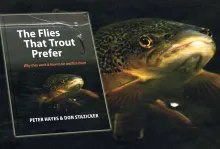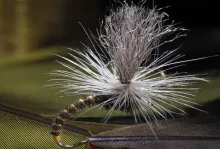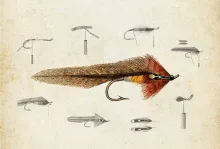The fascinating thing about AK is, that you start believing him and that many of his methods make sense. His approach is very personal, and he doesn't try to hide this.
Date: Wed, 10 May 1995 22:58:12 +0100 (MET)
OK book lovers,
My fishing vacation is over and the accumulated workload is almost gone, so once again it's time for one of those famous book reviews.
Before my recent week long search for a sea trout in the salty Danish waters, I was fortunate enough to recieve a book from Sue K in Colorado (thanks Sue). The book was:
- A.K.Best: production Fly Tying, A Collection of Ideas, Notions, Hints & Variations on the Technique of Fly Tying.
- Published by Pruett Publishing Company, Boulder Colorado, 1989
- Price: 42.- US$ (w.CO tax).
When I leafed through my copy after recieving it, I was initially dissapointed. As always when running my fingers through a book for the first time, I judged it by the lay out, the pictures and the overall structure of the chapters, sections etc. This book did not look very promising.
To me the B/W book looked dull and unapealling, and the photos of tying steps and flies looked clumsy both in regard to the photographic work and the fly tying.
John Gierachs intro was a bit too much too. 'This guy taught me how to really tie flies', 'A.K. ties 3,000 dozens of flies a year', 'Tying more than one fly is production'. Not my kind of tying philosophy exactly.
I started reading the book from cover to cover. Gierach recommends this but I tend to disagree. Even though my first scepticism was mellowed a bit by the chapter on tools and the chapter on tails, I had a hard time getting to the end of that second chapter. I put the book down and took it up again. Continued with bodies, wings and... well I actually didn't remember, because the whole thing passed by me like a landscape seen from a train. Nothing stuck, nothing seemed fascinating and I started wondering about what had made this book so appreciated by others.
A.K.'s way of writing was probably one of the things that made me irritated at first. He doesn't give advice or suggest how to do things, but just says: 'This is how I do it, and I truly wonder why everybody else does it different'. When everybody else uses two turns he uses one. When everybody else tries to get even, straight looking dry fly hackles, he tries to get his fuzzy and uneven. When everybody else pulls slowly upwards, he'll jerk downwards.
The fascinating thing about this is, that you start believing him and that many of his methods make sense. His approach is very personal, and he doesn't try to hide this. When you get used to the thought that this is 'fly tying according to A.K.', the book actually starts getting good, and the text makes sense and sticks.
He is of course very rational in his approach to fly tying. This guy obviously tie a lot of flies, and saving a split second on each fly is important to him. Preparationm, timesaving methods, economy of motion and less tools are ways of optimizing the tying process, and A.K. will emphasize these factors in his instructions. But what's not obvious in the start, but reveals itself after a second and even a third reading, is that his text is litterally stuffed with sound advice.
What initially seems like a rigid, maybe even superficial instruction will eventually be a very sensible, well argumented description of the proces. What seems to be hysterically minute details while reading in bed, will be just the needed information, when the book is read while actually performing the task described.
We all have our ways of doing things, and I surely don't agree with everything in this book. Still there's a lot to learn from every chapter both the ones treating new methods and the ones about methods that you feel you master already. It's very concentrated material and not many words are waisted on useless info or anecdotes.
This is not a book that encourages experiments, though. The aim is to tie flies consistently and not to turn from the proven path. A certain method is performed like this and in no other way, and a certain fly looks like this and in no other way. Deviations from this path has come through very thorough tests and after tying many, many flies in the new way. When the new method or material has been proofed, that's the one we use.
The book does deal with many different methods applied to many different flies, from tiny dries to large poppers and salt water flies. This makes the book a versatile collection of single methods, and I have already used it as a handbook for several tying steps. Everytime I read a chapter again, I'm surprised. There really is a lot of good, specific advice to be found.
I do miss a more general approach to the tying: using the thread torque (thread control), minimizing material use and bulk, methods to make durable flies, hook choice and more. Not even the tools section, which is pretty general, avoids being very specific: this bobbin holder, these scissors etc.
Also the index is lousy. What's the use of an index that mentions 'Price lamp', but not 'Palmer hackle'?
I would probably have lived happily without this book, and tied decent flies anyway. But no doubt that this book has made me think about a couple of things I never spent a minute thinking about. Like: How the hell can anybody tie 3,000 dozens (36,000) flies a year? That's 100 flies a day...!
No wonder rationalizing your methods is important. Save a second on each fly, and you have saved a whole working day (10 hours)--enough to tie another 100 flies.
Happy reading
- Log in to post comments









At age 86, I might a
At age 86, I might appreciate the time saving.
Production Fly tying
Production Fly tying is an excellant book. Very easy to understand and use. Lots of "why didn't I think of that" ideas ! One of the VERY BEST tying books...NOT FOR BEGINNERS....you really need to be an intermediate tyer to get your moneys worth.